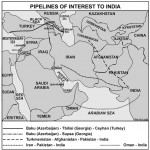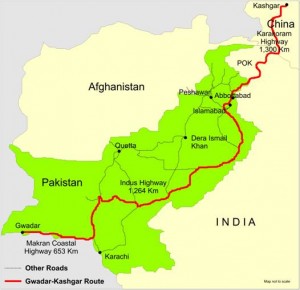 In the year 2017, India suddenly found itself as a peculiar cog in the emerging superpower rivalry between rising and aggressive China’s deep designs as reflected in BRI (Belt and Road Initiative), CPEC and its almost unilateral initiatives to change facts on ground under these initiatives and the USA under a new President.
In the year 2017, India suddenly found itself as a peculiar cog in the emerging superpower rivalry between rising and aggressive China’s deep designs as reflected in BRI (Belt and Road Initiative), CPEC and its almost unilateral initiatives to change facts on ground under these initiatives and the USA under a new President.
India as Twin Vertex
Trump administration in US in its first year has positioned India as a key element of its National Security Strategy and a major global power as reflected in “Indo-Pacific” characterization and arc of democracies in the region with the revival of Bush era (2007) “Quad” – comprising Japan and Australia as well.
President Trump’s US along with Japan, Australia and India has chosen year 2017 to revive the decade old proposal for quadrilateral security arrangement. Although detailed analytical explanations and comprehensive deep dives into various drivers for revival of the “quad” at this juncture are still some way ahead in popular press, it is somehow clear that all four vertices – US, Japan, Australia and India – of the quadrilateral have specific concerns with respect toChina that has started acting openly as an aggresive superpower since 2013 when President Xi assumed power.
It should be noted that China was already becoming more assertive before Xi, however, the manifestation of Silk Route Revival as Belt and Road Initiatives has indeed been a step change in the existing geo-political ground situation. (Please see My article on Silk Road Revival)
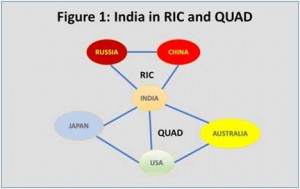 India as one of the vertices of the Quad need to juxtaposition the new groupingon what has been called the RIC forum – Russia India and China. The RIC trilateral grouping has been established since 2002 and it completed 15 years of its existence in 2017. Russia, as also its earlierversion as the USSR – a superpower, has been a trusted friend of India, especially when it comes to military hardware and technology. Ironically, the RIC started as a counterbalancing construct against the USA in the unipolar world at the start of the millennium.
India as one of the vertices of the Quad need to juxtaposition the new groupingon what has been called the RIC forum – Russia India and China. The RIC trilateral grouping has been established since 2002 and it completed 15 years of its existence in 2017. Russia, as also its earlierversion as the USSR – a superpower, has been a trusted friend of India, especially when it comes to military hardware and technology. Ironically, the RIC started as a counterbalancing construct against the USA in the unipolar world at the start of the millennium.
India is a unique vertex in the two groupings – the RIC and the Quad. Indian uniqueness stems not only from it being a common vertex in both the constructs but also its shift from non-alignment of the past to an emerging “multi-alignment” posture. India would like to believe that its twin vertex position what can be shown as in Figure 1. This belief may position India as a unique power that will become a diplomatic, strategic and potentially a geo-political catalyst to harmonize the two groupings.
Superpower Games in the Web of Intricacies
Such a belief, however, may not stand the finer scrutiny. US and China are becoming Global superpower rivals rapidly. The previous cold war lessons clearly indicate the way superpowers confront each other are through their surrogates. Also, the chessboard for both superpowers tends to be the whole world rather a specific region. Using the previous cold war thinking, India should view the RIC-Quad groupings more as shown in Figure 2.
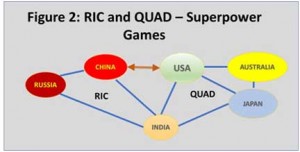 China-Russia Vs USA is the new world conflict that is being played out. India as a counter-weight and a potential surrogate due to its obvious scale is the most appropriate option for US against China. It is useful for USA that India and China share a decades old boundary dispute. Playing this game as an important chessboard piece may not be for India’s liking and in fact India may get bogged down into the superpower rivalry, when its potential to come out of centuries of subjugation and last 7 decades of lifting itself after independence are emerging to bear fruits as an economic revived nation.
China-Russia Vs USA is the new world conflict that is being played out. India as a counter-weight and a potential surrogate due to its obvious scale is the most appropriate option for US against China. It is useful for USA that India and China share a decades old boundary dispute. Playing this game as an important chessboard piece may not be for India’s liking and in fact India may get bogged down into the superpower rivalry, when its potential to come out of centuries of subjugation and last 7 decades of lifting itself after independence are emerging to bear fruits as an economic revived nation.
India can well learn from China. In the cold war decades of 1970s and 1980s and even in 1990s, China focused on getting itself extricated from poverty and economic depth. During those decades it pursued its own foreign policy rather than that of two superpowers. It also continued to learn from others failures and successes. Mid 1990s to first two decades of this century, China has become used to continuous rapid growth. If and when the growth gets impacted adversely or dented, Dragon may become more assertive and militarily active. A 2014 Rand Research Brief provides three potential Asian futures (a) Systemic Continuity – China continues to be cooperative but more assertive (b) Hegemonic China and (c) Systemic Breakdown. The report further states that current situation points more in between the first two futures.
One change however visible in the emerging superpower rivalry between China and USA, compared to US and USSR, is the emergence of a kind of multi-polar world with intricate connections between various poles in multiple dimensions. Each of these powers have unique capabilities – be it economic power, military power, technology power, soft power, smart power or sharp power.
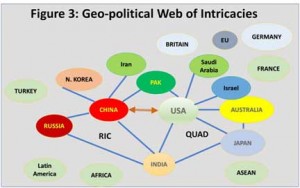 Modern superpowers need to play the soft, smart and sharp power in conjunction with economic, military and technology power of the previous cold war. This is a new game exacerbated by new form of networks where the flow of people, material, money and culture has increased not only in terms of quantity but also in terms of exponential speed. Globalization has unlocked new type of power dimensions that state powers has never experienced in such ferocity before.
Modern superpowers need to play the soft, smart and sharp power in conjunction with economic, military and technology power of the previous cold war. This is a new game exacerbated by new form of networks where the flow of people, material, money and culture has increased not only in terms of quantity but also in terms of exponential speed. Globalization has unlocked new type of power dimensions that state powers has never experienced in such ferocity before.
Multi-Alignment or Agile Strategic Adaptability
India pursued a non-alignment policy in Warsaw Pact-NATO rivalry. Pakistan always pursued a power alignment – always belonging to a power grouping that can give it maximum resources to feed-on. For whatever the political drivers, Self-sufficiency as the focus has helped India and with minimum political alignment to the geo-political super powers, India has wriggled past the turbulent history of the last 7 decades.
By abandoning non-alignment as in a unipolar world, the non-alignment lost its meaning, India has worked against every hegemony. The RIC grouping in 2002 was to strengthen a potential pole against the sole superpower, i.e., USA. In 2017, China is transforming as a hegemon from its assertive avatar at the start of this decade. India attempt to counter China clearly has lead to its acceptance of Quad. India would like to reshape its non-alignment as multi-alignment as in aligning with specific powers in RIC or QUAD or in any other security or economic groupings based on shared common interests.
However, given the world is already connecting in the new forms of networks in multi-dimensions no nation or power will have luxury of time and resources to design its policy with visibility of a chess board. What should India do in the networked world where the emergent superpowers will play cold war again?
Agile Strategic Adaptability In the games of networked pieces where rules of the games are emergent and the visible board is just one particular version of the game, Agile Strategic Adaptability has to be developed and practiced. This will require a comprehensive description, detailing and development of what constitutes India’s national interests and how these interests need to be the guiding lights in all our interactions in a world rapidly changing through multi-dimensional interactions at the level of individuals.
Further, India should build strong bilateral relationships with all the major poles and players, instead of falling in a particular grouping.
Finally, given the relative value of each nation in a multi-polar world is increasing in unfathomable dimensions, it is essential that trust be built with everyone in as many dimensions as one can. India should invest in building diplomatic corps of non-government structures to interact with every nation in all groupings – agile strategic adaptability in a multi-dimensional world requires a capability and infrastructure for multi-alignment with every single nation on the basis of common, clear and comprehensive interests that need to be defined, developed and refined in the contexts that may emerge in future.




